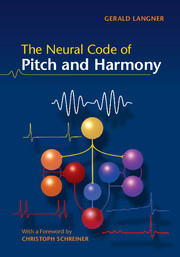Book contents
- Frontmatter
- Contents
- Preface
- Foreword
- 1 Historical aspects of harmony
- 2 Sound and periodicity
- 3 The discovery of the missing fundamental
- 4 The pitch puzzle
- 5 The auditory time constant
- 6 Pathways of hearing
- 7 Periodicity coding in the brainstem
- 8 Periodicity coding in the midbrain
- 9 Theories of periodicity coding
- 10 Periodotopy
- 11 The neural code of harmony
- 12 The oscillating brain
- References
- Index
11 - The neural code of harmony
Published online by Cambridge University Press: 05 May 2015
- Frontmatter
- Contents
- Preface
- Foreword
- 1 Historical aspects of harmony
- 2 Sound and periodicity
- 3 The discovery of the missing fundamental
- 4 The pitch puzzle
- 5 The auditory time constant
- 6 Pathways of hearing
- 7 Periodicity coding in the brainstem
- 8 Periodicity coding in the midbrain
- 9 Theories of periodicity coding
- 10 Periodotopy
- 11 The neural code of harmony
- 12 The oscillating brain
- References
- Index
Summary
‘The essential basis of music is melody.’
Helmholtz, The Sensation of Tones, 3rd edition, 1913The pitch helix
The pitch helix is a highly relevant concept in the psychology of music. Two nineteenth- century German mathematicians, Friedrich Wilhelm Opelt (1794 – 1863) and Moritz Wilhelm Drobisch (1802 – 1896), were the first to suggest a helical model to represent the sensation of pitch, octave equivalence and recurrence (Opelt, 1852; Drobisch, 1855).
Opelt started his career as a weaver, but later became a director of the Sächsisch- Bayrische Staatseisenbahn. Among astronomers he is still famous for his maps of the moon. Drobisch was a professor of mathematics and philosophy at the University of Leipzig and still has an enduring reputation in empirical psychology and logic.
The concept of a helical organization underlying the sensation of pitch can be related to neuronal mechanisms of temporal processing in the auditory system. Moreover, as the final chapter of this book will show, a helical organization is not restricted to mechanisms of hearing. Anatomical evidence for a variety of helical structures in non-auditory brain areas support a theory of harmonic processing of oscillatory brain signals even beyond the level of the hearing system.
But first we will have to understand the role of harmony for periodicity processing and pitch perception and the related concept of the pitch helix. It seems trivial that the pitches of two tones are perceived as very similar if their fundamental frequencies are nearly the same. Tones should sound similar, even if they do not activate the same neurons, provided they at least activate adjacent neurons in the pitch maps of the brain. However, two tones which differ in frequency by 100% (an octave) suddenly become similar again; in fact, they are often confused and may be quite difficult to distinguish if played, for example, by different instruments.
- Type
- Chapter
- Information
- The Neural Code of Pitch and Harmony , pp. 162 - 180Publisher: Cambridge University PressPrint publication year: 2015



